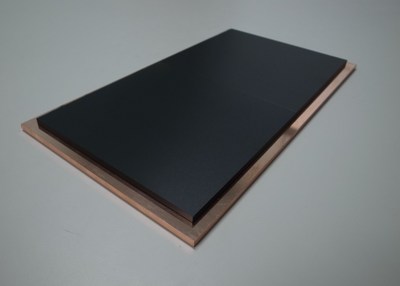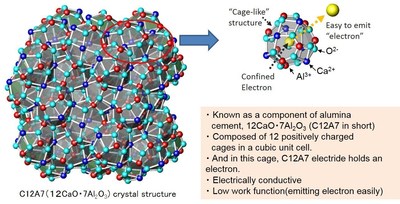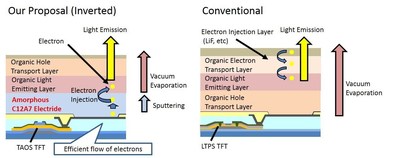TMCnet News
AGC Develops Amorphous Thin Film Using Unique Sputtering Target MaterialTOKYO, May 25, 2016 /PRNewswire/ -- AGC Asahi Glass (AGC) today announced it has developed a uniform amorphous thin film using a unique sputtering target material, and has started industrialization and commercial production of the material. Called C12A7 Electride, the material is essential to mass production of both the new thin film and large organic electroluminescent (EL) panels – also known as organic LEDs (OLEDs) – utilizing the film.  Currently, lithium fluoride (LiF) and alkali-doped organic materials are used as the electron injection material for an OLED display. However, these materials are unstable and are used in an unstable state, which contributes to manufacturing challenges associated with OLED. To address this problem, the AGC Group developed the more stable amorphous C12A7 Electride thin film. C12A7 is a component of alumina cement. Its structure comprises interconnected "cages," measuring about 0.4 nanometers (nm) in inner diameter, that contain oxygen ions. C12A7 Electride was developed at the Tokyo Institute of Technology by a research group under Professor Hideo Hosono, a material scientist known for the discovery of iron-based superconductors. All of the oxygen ions in the cages are replaced with electrons, enabling the material to conduct electric current like a metal, maintain chemical and thermal stability, and be easy to handle, while retaining the characteristic of readily emitting electrons.  The amorphous C12A7 Electride thin film, which can be formed through a sputterng process [1] at room temperature using the AGC Group-developed target material, has the following unique characteristics: it is transparent in the visible range; it can emit electrons as easily as metal lithium can; and it is chemically stable even in the atmosphere. By combining this with the TFT element, which uses a transparent amorphous oxide semiconductor (TAOS), the low-driving-voltage electron transport layer can be manufactured stably and with high production yields, even when used in an OLED display with an inverted structure.  Market research firm IDTechEx forecasts the market for OLED displays will reach nearly US$16 billion this year and will grow to US$57 billion in 2026. AGC Group's Naomichi Miyakawa, Principal Manager, New Product R&D Center, Technology General Division, noted, "TAOS-TFT is suitable for driving a large OLED panel, but there was no available material that functions properly as both an electron injection layer and an electron transport layer – both of which are necessary to realize the inverted structure that makes the best of the panel's performance. With the commercialization of our C12A7 Electride material, we expect to see substantially improved production of oxide TFT-driven OLED panels." AGC anticipates OLED panels integrating the new C12A7 Electride-based thin film to begin manufacture in the year of Tokyo Olympic Games, 2020 or earlier. Note:
About the AGC Group AGC Asahi Glass (also called AGC, Registered Company name: Asahi Glass Co., Ltd., Headquarters: Tokyo, President & CEO: Takuya Shimamura) is the parent company of the AGC Group, a world-leading glass solution provider and supplier of flat, automotive and display glass, chemicals, ceramics and other high-tech materials and components. Based on more than a century of technical innovation, the AGC Group has developed a wide range of cutting-edge products. The AGC Group employs some 50,000 people worldwide and generates annual sales of approximately 1.3 trillion Japanese yen through business in about 30 countries. Under its management policy, AGC plus, the AGC Group manufactures products that provide "new value and functions" for its customers. As a pioneer of display materials, including glass substrates and cover glass, the Group will promote technological innovations to offer new added-value products that satisfy its customers. For more information, please visit www.agc-group.com. Photo - http://photos.prnewswire.com/prnh/20160525/372062
To view the original version on PR Newswire, visit:http://www.prnewswire.com/news-releases/agc-develops-amorphous-thin-film-using-unique-sputtering-target-material-300275098.html SOURCE AGC Asahi Glass 
|
